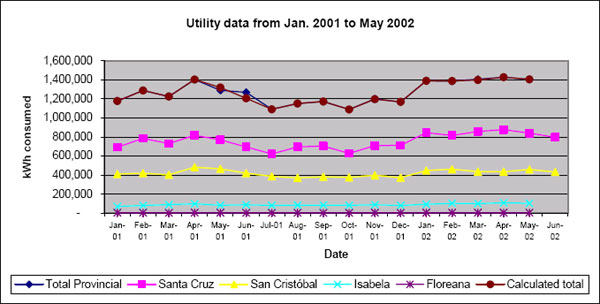Electrical Power
The basic solution proposed for the electrical power on the Galapagos Islands is three-fold. The primary power will come from an extensive grid of wind power generators, both on and offshore. The secondary source will be backup high efficiency diesel turbine generators, which have relatively low emissions. The last component will be distributed solar and experimental tidal generators which can generate power under low wind situations and to supplement the primary power grid. Certain components of the grid will run through kinetic energy storage, which acts similar to a battery in storing energy when there is a surplus and releasing it during peak usage periods or when there is a generation deficit.
Current Situation
Currently, power for the islands is supplied by diesel generators that use high sulfur diesel fuels. The diesel generators run between four and twelve hours a day. The internal combustion engines that harness the energy in the diesel generators contain hundreds of moving parts that require continuous, expensive maintenance. High sulfur diesel fuels result in high particulate emissions that have been shown to be a significant respiratory threat. The diesel must be shipped to the islands, and current shipping practices have resulted in at least one major spill during such a delivery. The diesel fuel is handled and stored several times between delivery onto the islands and the actual use of the fuel and at each storage point leaks occur because of poor storage plans, a lack of secondary containment systems in the event that leaks occur, and poorly designed transfer mechanisms between the tanks and receptacles. The current energy demand on San Cristobal is about four megawatts.

(Ley, 2002)
[top]
Wind Power
There is a current proposal, by the non-profit e7 group, to build about 2.7 megawatts capacity of wind turbines on San Cristobal. They will be placed in locations which should minimize the impact on local birds and wildlife. This proposal is summarized in this pdf file: http://galapagos.solarquest.com/PublicAudience/Audience.pdf
This system can be supplemented with offshore farms, which have the advantage of even less impact on wildlife, and generally benefit from steadier winds. Some efficiency is lost from the transmission of power over several kilometers over electrical lines. This can be reduced by transmitting at high voltages.
Impact
Numerous studies have been done that show that wind turbines do not have a significant effect on birds. One study in Denmark and two studies in California have been done to look at the impact the wind turbines have on birds. It has been shown that a bird will only collide with a wind turbine once every eight or fifteen years. The frequency of collisions increases in areas of high migration. Another study was done in the Altamont Pass Wind Resource Area that showed that over a two-year period, 182 birds died due to collisions with wind turbines in an area with 7,000 wind turbines. Bird deaths due to collisions with wind turbines only account for .01% to .02% of all bird deaths. This number is so low because birds are able to redirect their path of travel. Danish radar research has shown that birds travel 100-200 meters out of the path of a wind turbine when they near one in the day or night.
Although there seem to be few bird deaths due to wind turbines, there are still ways to prevent those bird deaths that do occur. One way to reduce the negative effect that wind turbines have on birds is to reduce the number of bird perches on the turbine. If there are less perches, then not as many birds will be able to land and as a result, less harm will come to the birds. A second way to limit the harm done to birds is by carefully placing the wind turbines. By examining the wind flow and how birds use a given area, many collisions can be reduced. Also, the blades of the wind turbines can be painted in such a way to emphasize their contrast from the background which should help to guide the birds away from the blades.
[top]
Diesel Backup
The proposed diesel generators use modern materials and as a result have high thermal efficiency and few emissions. They will be used to supplement the renewable energy sources when needed, and as emergency backup power to essential infrastructure.
[top]
Kinetic Energy Storage
Flywheels rotating at very high speeds attached to motors act very well as energy storage devices. They have a number of advantages over batteries, such as longer life, no toxins, more reliability, and no concerns about charge/discharge cycles. You can read more about them at: http://www.uptenergy.com/. They have been tested in many situations, including many large urban subway systems.
These devices will be used to smooth out the power coming from alternative power sources (which can have irregular current), and to store power for times when there is not enough wind.
[top]
Floating Island
The floating island will be the point of distribution for diesel fuel to boats and aviation fuel to airplanes. The power on the platform will largely be provided by tidal sources, and probably supplemented with solar and diesel generators. See the floating island proposal for more information.
[top]
Other Power Sources
There are a number of other special situation power sources as well. For example, experimental on-shore tidal stations could be used at certain locations to supplement wind power. [http://www.bwea.com/marine/devices.html] However, because these technologies are so new and untested, they should not form the basis of the overall grid. Solar power and other tidal power technologies should be used as much as possible in the design of sensor systems and research outposts.
[top]
Other Energy Possibilities
Geothermal
It has been decided that geothermal, while a very attractive energy source, would require too much damaging exploration and constructive to be worthwhile.
Also, one of the most attractive aspects of geothermal is its use in heating. Because of the warm climate on the Galapagos, this is irrelevant.
Solar
Solar, using current technology, has far too high a cost per kilowatt hour to be practical. It offers no practical benefits over wind power.
Solar is appropriate for more distributed power generation. For example, remote sensors, buoys, and night lighting can be run off solar.
Hydrogen
Hydrogen is not a solution on it's own. It is only a medium to store already generated energy. That energy still has to be generated seperatly, and the process of creating, storing, and transporting hydrogen introduces a lot of overhead. Also, clean, desalinated water is required to generate hydrogen, and that is not an abundant resource on the islands.
[top]
Sources
- An Assessment of Energy and Water in the Galápagos Islands. http://galapagos.solarquest.com/documents/SandiaGalapagosReport200307.pdf. Visted: 11/27/04.
- (2001) Facts About Wind Energy and Birds. American Wind Energy Association.
- Wind Turbines and Birds. AusWEA (Australian Wind Energy Association).
[top]
Copyright! All rights reserved. Webmasters


